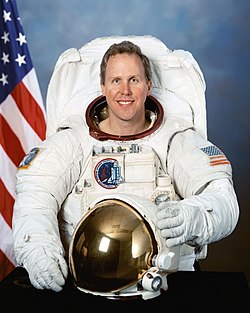Career
A distinguished graduate of the USAF Academy, Jones served on active duty as an Air Force officer for six years. After pilot training in Oklahoma, he flew strategic bombers at Carswell Air Force Base, Texas. As pilot and aircraft commander of a B-52 D Stratofortress, he led a combat crew of six, accumulating over 2,000 hours of jet experience before resigning as a captain in 1983.
From 1983 to 1988, Jones worked toward a Ph.D. at the University of Arizona in Tucson. His research interests included the remote sensing of asteroids, meteorite spectroscopy, and applications of space resources. From 1989 to 1990, he was a program management engineer in Washington, D.C., at the CIA's Office of Development and Engineering. In 1990 he joined Science Applications International Corporation in Washington, D.C. as a senior scientist. Jones performed advanced program planning for NASA's Solar System Exploration Division, investigating future robotic missions to Mars, asteroids, and the outer Solar System.
After a year of training following his selection by NASA in January 1990, Jones became an astronaut in July 1991. In 1994 he flew as a mission specialist on successive flights of Space Shuttle Endeavour. In April 1994, he ran science operations on the "night shift" during STS-59, the first flight of the Space Radar Laboratory (SRL-1). Then, in October 1994, he was the payload commander on the SRL-2 mission, STS-68. Jones next flew in late 1996 on Space Shuttle Columbia. STS-80 successfully deployed and retrieved 2 science satellites, ORFEUS/SPAS and the Wake Shield Facility. While helping set a Shuttle endurance record of nearly 18 days in orbit, Jones used Columbia's robot arm to release the Wake Shield satellite and later grapple it from orbit. His latest space flight was aboard Space Shuttle Atlantis on STS-98, in February 2001. Jones and his crew delivered the Destiny module to the International Space Station, (ISS) and he helped install the Lab in a series of three spacewalks lasting over 19 hours. The successful addition of Destiny gave the first Expedition Crew the largest space outpost in history and marked the start of onboard scientific research at the ISS. A veteran of four space flights, Jones has logged over 52 days (1,272 hours) in space.
Since leaving NASA in 2001, Jones has worked as a planetary scientist and consultant in space operations. He is a senior research scientist at the Florida Institute for Human and Machine Cognition, engaged in planning robotic and astronaut expeditions to deep space and the near-Earth asteroids. He is also an author and speaker, [2] with four adult, non-fiction works to his credit. From 2006 to 2009 he served on the NASA Advisory Council. He is a board member of the Astronauts Memorial Foundation. [3]
He appears frequently as a science/space commentator on radio and television.
This page is based on this
Wikipedia article Text is available under the
CC BY-SA 4.0 license; additional terms may apply.
Images, videos and audio are available under their respective licenses.
